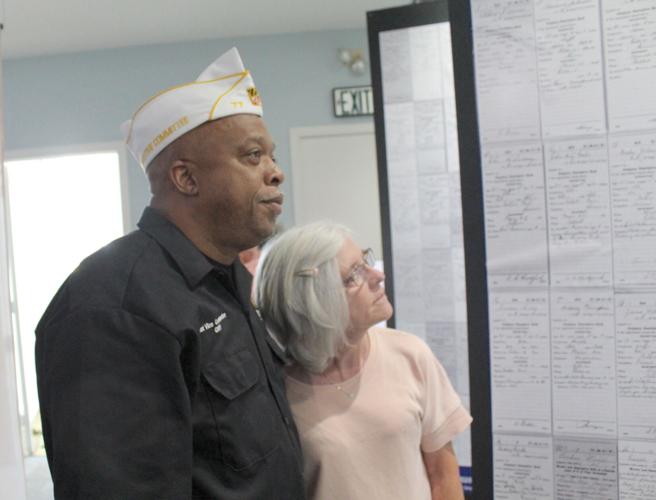EASTON — A new exhibit is documenting the often untold stories of hundreds of African American men from Talbot County who fought for their freedom in the Civil War.
And while the project put on by the Talbot Historical Society aims to tell the history of free and enslaved Black men in the Civil War, it doesn’t stop there. Extensive research dating back months has helped uncover the names and details of more than 500 Black soldiers from Talbot County.
Clara Small, a retired professor and historian, speaks to a large crowd on Tuesday about the sacrifices made by hundreds of African Americans who served as soldiers in the Civil War.
KONNER METZ/STAR DEMOCRATBefore the exhibit’s soft opening to the public Tuesday, retired Salisbury University professor and historian Clara Small delivered a moving lecture to a packed room in the Talbot County Free Library.
“This exhibit will help to put flesh on those names,” Small said. “The goal is that it’s not just a name anymore, but a human being. One of your ancestors.”
The exhibit — “Talbot County’s United States Colored Troops: A Story of Valor and Honor” — is located on South Washington Street in downtown Easton. The list of names hangs on one end of the exhibit, though that catalog is continuously being updated as historians learn more about the local soldiers.
During the Civil War, as Small noted, the border state of Maryland did not meet its quota for Union Army soldiers. Many white soldiers avoided fighting through fees or purchasing substitutes, she said.
“The solution was to use free Blacks and slaves because they provided an unlimited reservoir of manpower,” Small said, noting how many Marylanders and slaveholders rejected the idea of using Black troops, fearing a loss of labor.
Abolitionist and Talbot County native Frederick Douglass advocated for the inclusion of Black soldiers in the Union Army. His work, along with Abraham Lincoln’s authorization for the recruitment of slaves, made the United States Colored Troops possible.
Small noted around 180,000 Black men served in the Union Army, with more than 8,000 from Maryland and around 600 or 700 from Talbot County.
Research conducted by the Talbot Historical Society and partnering groups sheds light on the many free and enslaved Black men from Talbot County who answered the call but never received the same recognition white soldiers were granted.
Historical Society member Paul Callahan said it took hours of research, collaboration with local organizations like Easton’s American Legion Post 77 and consultation with Small to prepare the list of names.
“I saw so many family names, friends that I grew up with in Oxford,” Callahan said. “ ... I don’t even think they knew that their ancestors were American heroes who fought in the war so valiantly.”
The exhibit has records and an electronic database where people can learn specifics about the soldiers: birthplace, date of death, height, eye color, regiment, rank and more. Callahan says it’s a tool to empower Talbot County residents to learn more about history and their ancestries.
Historians relied on the online military record database Fold3, as well as records in the library’s Maryland Room and from local families or veteran groups.
“It was very tedious,” Callahan said.
Some of the artifacts and items on display in the exhibit come from a Civil War reenactment group in Philadelphia. Project leaders also consulted descendants of the 18 U.S. Colored Troops who founded the Unionville community after the war.
During her lecture, Small said the research makes the Civil War more “personable” for local residents. She emphasized that Black families will be better able to trace their heritage.
“There should be very few people in this county that are not connected to some of these men in some way, whether it is by marriage, as cousins or as cousins of cousins,” Small said.
The renowned professor highlighted the unfair and discriminatory treatment Black soldiers received even after the Union’s victory in the war. She encouraged attendees to tell the accounts of the free and enslaved Black soldiers, stories that aren’t told nearly enough.
“That is a legacy that is often forgotten, neglected or is purposely left out of our history books,” Small said. “It is way past the time to correct those myths, perceptions and erroneous beliefs.”
“This is just the tip of the iceberg,” Small added. “We have a lot of work to do.”
The Talbot County United States Colored Troops exhibit is located at the Talbot Historical Society at 25 S Washington St. It is open Wednesdays through Saturdays from 10 a.m. to 3 p.m.















(0) comments
Welcome to the discussion.
Log In
Keep it Clean. Please avoid obscene, vulgar, lewd, racist or sexually-oriented language.
PLEASE TURN OFF YOUR CAPS LOCK.
Don't Threaten. Threats of harming another person will not be tolerated.
Be Truthful. Don't knowingly lie about anyone or anything.
Be Nice. No racism, sexism or any sort of -ism that is degrading to another person.
Be Proactive. Use the 'Report' link on each comment to let us know of abusive posts.
Share with Us. We'd love to hear eyewitness accounts, the history behind an article.